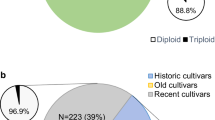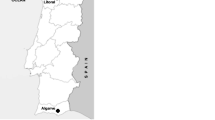Abstract
In this paper, the microsatellite (SSR) loci analysis was used to study apple genotypes with different levels of ploidy. A total of 47 samples were studied (9 diploids, 21 triploids, and 17 tetraploids) for seven microsatellite loci (GD147, Hi02C07, CH02c11, CH04c07, CH03d07, CH02c09, and GD12). It was possible to refine the pedigrees for some forms. It was established that the tetraploidss 20-9-30 and 20-9-27, selected in a hybrid family from the crossing of Wealthy 4x and Antonovka Obyknovennaya, were probably obtained from the self-pollination of the maternal form, since in the most loci they did not inherit alleles from the paternal form. As a result of the alleles distribution analysis, the spontaneous triploid cultivars Nizkorosloe and Sinap Orlovsky were revealed to be formed from the merge of an unreduced ovum and haploid pollen, since in the heterozygous loci both alleles are inherited from the maternal form and only one from the paternal form. According to the obtained data, studied tetraploids may be divided into two groups, which also reflect the features of tetraploids origin. The first group includes tetraploids inherited alleles from one initial diploid form (including spontaneous and induced tetraploids, as well as forms from self-pollination of the tetraploid maternal form). These teraploids, like diploids, amplify 1–2 alleles per locus (on average, for all 7 loci, one genotype amplifies 13 alleles). The second group includes tetraploids carrying alleles from several initial diploid forms. Tetraploids of this group are highly heterozygous and amplify 3–4 alleles at most loci (the maximum number of alleles at all loci, 24 alleles, was identified in the form 30-47-88). Tetraploids of the second group have a greater potential for the genetic diversity of its offspring. Analysis of polymorphism of microsatellite loci can be used (1) as an alternative or additional method for identifying the triploid hybrids from heteroploid crosses of orthoploid forms, which is based on the analysis of the loci most polymorphic in parental forms, and (2) for the analysis of true hybridity (verification of pedigrees), including tetraploid forms. Moreover, we identified the most polymorphic loci suitable for the above purposes. The aspects of qualitative and quantitative interpretation of the fragment analysis of microsatellite loci results are considered. The possibilities and limitations of the SSR analysis for detection of apple ploidy level are discussed.
Similar content being viewed by others
References
Sedov, E.N., Innovations in the Evolution of the Apple Genome, in Novye perspektivy v selektsii (New Perspectives in Breeding), Orel: Vserossiiskii Nauchno-Issledovatel’skii Institut Selektsii Plodovykh Kul’tur, 2015, pp. 43–163.
Sedov, E.N., Sedysheva, G.A., and Serova, Z.M., Selektsiya yabloni na poliploidnom urovne (Breeding of Apple Trees at the Polyploid Level), Orel: Vserossiiskii Nauchno-Issledovatel’skii Institut Selektsii Plodovykh Kul’tur, 2008.
Zhuchenko, A.A., Ekologicheskaya genetika kul’turnykh rastenii i problemy agrosfery (teoriya i praktika) (Ecological Genetics of Cultivated Plants and the Problems of Agrosphere (Theory and Practice)), Moscow: Agrorus, 2004.
Shilov, I.A., Application of the technology of microsatellite DNA analysis in plant growing, in Problemy agrobiotekhnologii (Problems of Agrobiotechnology), Kharchenko, P.N., Ed., Moscow, 2012, pp. 140–162.
Pikunova, A.V., Sedov, E.N., and Serova, Z.M., Results of genotyping of 19 apple-tree cultivars selection at microsatellite loci by All-Russian Research Institute of Fruit Crop Breeding, in Selektsiya, genetika i sortovaya agrotekhnika plodovykh kul’tur (Breeding, Genetics and Fruit Crops Agrotechnics), Orel: Vserossiiskii Nauchno-Issledovatel’skii Institut Selektsii Plodovykh Kul’tur, 2013, pp. 16–26.
Kalia, R.K., Rai, M.K., Kalia, S., et al., Microsatellite markers: an overview of the recent progress in plants, Euphytica, 2011 vol. 177, no. 3, pp. 309–334.
Reim, S., Flachowsky, H., Hanke, M.V., and Peil, A., Verifying the parents of the Pillnitzer apple cultivars, Acta Hortic., 2009, vol. 814, pp. 319–323.
Cabe, P.R., Baumgaten, A.O., Kyle Luby, J.J., et al., Using microsatellite analysis to verify breeding records: a study of “Honeycrisp” and other cold-hardy apple cultivars, Hort. Sci. (Prague), 2005, vol. 40, vol. 1, pp. 15–17.
Suprun, I.I., Tokmakov, S.V., Malyuchenko, O.P., et al., Genotyping of apple cultivars of Russian selection using microsatellite markers, Izv. Timiryazev S.-kh. Akad., 2011, no. 6, pp. 162–166.
Suprun, I.I., Ushakova, Ya.V., Tokmakov, S.V., et al., Study of the genetic diversity of modern apple (Malus domestica) cultivars of domestic selection using microsatellite loci, S.-kh. Biol., 2015, vol. 50, no. 1, pp. 37–45.
Shamshin, I.N., Kudryavtsev, A.M., and Savel’ev, N.I., Analysis of genetic polymorphism of the apple genome using microsatellite DNA sequences, in Nauchnye trudy Severo-Kavkazskogo zonal’nogo nauchno-issledovatel’skogo instituta sadovodstva i vinogradarstva: metodologicheskoe obespechenie selektsii sadovykh kul’tur i vinograda na sovremennom etape (Scientific Works of The North Caucasian Zonal Scientific Research Institute of Horticulture and Viticulture: Methodological Support of Breeding of Garden Crops and Grapes at the Present Stage) (Mater. nauch.-prakt. foruma Rol’ ekologizatsii i biologizatsii v povyshenii effektivnosti proizvodstva plodovykh kul’tur, vinograda i produktov ikh pererabotki (Proc. Theor. Pract. Forum The Role of Ecologization and Biologization in Increasing the Efficiency of Production of Fruit Crops, Grapes and Products of Their Processing)), 2013, pp. 39–42.
Diversity Arrays Technology P/L (DArT). http://www.DiversityArrays.com.
Liebhard, R., Gianfranceschi, L., Koller, B., et al., Development and characterisation of 140 new microsatellites in apple (Malus × domestica Borkh.), Mol. Breed., 2002, vol. 10, vol. 4, pp. 217–241.
Galli, Z., Halász, G., Kiss, E., et al., Molecular identification of commercial apple cultivars with microsatellite markers, Hortic. Sci., 2005, vol. 40, pp. 1974–1977.
Urrestarazu, J., Denancé, C., Ravon, E., et al., Analysis of the genetic diversity and structure across a wide range of germplasm reveals prominent gene flow in apple at the European level, BMC Plant Biol., 2016, vol. 16, no. 1, p. 130. doi 10.1186/s12870-016-0818-0
Sedov, E.N., Sedysheva, G.A., Serova, Z.M., and Gorbacheva, N.G., Self-fertility of the apple tree polyploid cultivars and forms, Dokl. Ross. Akad. S.-kh. Nauk, 2014, no. 3, pp. 21–23.
Van Dijk, T., Pagliarani, G., Pikunova, A., et al., Genomic rearrangements and signatures of breeding in the allo-octoploid strawberry as revealed through an allele dose based SSR linkage map, BMC Plant Biol., 2014, vol. 14, no. 1, p. 55. doi doi 10.1186/1471-2229-14-55
Sedov, E.N., Sedysheva, G.A., Krasova, N.G., et al., Origin, economic and cytoembryological characteristics of the triploid apple-tree Sinap Orlovsky, Ross. S.-kh. Nauka, 2017, no. 1, pp. 14–18.
Sedysheva, G.A., Sedov, E.N., Gorbacheva, N.G., et al., Cytological control in apple breeding on the polyploid level, Dostizh. Nauki Tekhn. Agroprom. Kompleksa, 2013, no. 7, pp. 11–13.
Doležel, J., Greilhuber, J., Lucretti, S., et al., Plant genome size estimation by flow cytometry: inter-laboratory comparison, Ann. Bot., 1998, vol. 82, pp. 17–26.
Author information
Authors and Affiliations
Corresponding author
Additional information
Original Russian Text © A.V. Pikunova, E.N. Sedov, S.V. Tokmakov, I.I. Suprun, N.G. Gorbatchova, M.A. Dolzhikova, T.V. Yanchuk, Z.M. Serova, 2018, published in Genetika, 2018, Vol. 54, No. 4.
Rights and permissions
About this article
Cite this article
Pikunova, A.V., Sedov, E.N., Tokmakov, S.V. et al. Microsatellite Loci Polymorphism of Apple (Malus domestica Borkh.) Genotypes with Different Ploidy Level. Russ J Genet 54, 442–450 (2018). https://doi.org/10.1134/S1022795418040129
Received:
Accepted:
Published:
Issue Date:
DOI: https://doi.org/10.1134/S1022795418040129




